The U.S. Navy’s engineering community has started conducting light carrier design studies, according to Megan Eckstein at USNI News here.
Rear Adm. Jason Lloyd, the SEA 05 commander and deputy commander for ship design, integration and engineering was reported as saying:
“We have looked at an America-class possibility, we have looked at a Ford-class-light, we’ve looked at various different options and done cost studies on all those options.
There are also capabilities studies on all those options. An aircraft carrier in World War II is not the same as a Nimitz-class carrier; there have been a lot of lessons learned over the years such as being able to do simultaneous launch and recovery, such as being able to safely maneuver aircraft once they’ve landed and still do simultaneous launch.
So there’s a lot to an aircraft carrier flight deck that has been lessons learned over the years. So to go to a CVL light that we talked about has some tradeoffs.
We say that it could be significantly less expensive, and it can be, it could be less expensive, but there are tradeoffs to that. So we have to go figure out what it’s going to be.”
Lloyd continued by saying that the team started by dusting off previous carrier studies the Navy has done.
You can read more from the original source here.


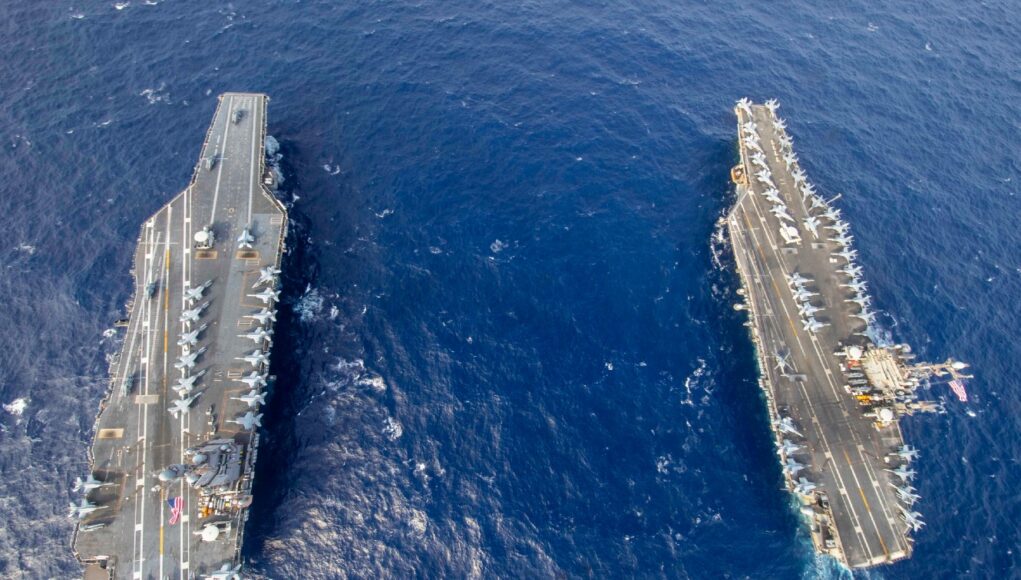
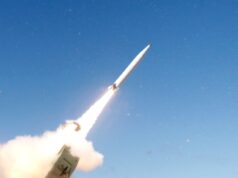
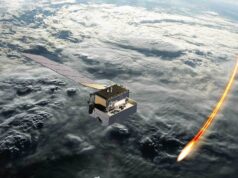
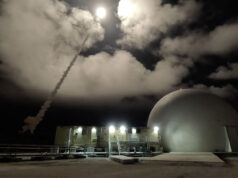


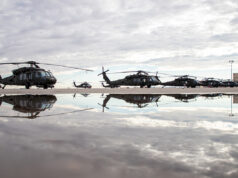

Is the QE design in serious contention?
If they decide that light carriers are non-nuclear then that will drive many of their decisions in the direction of a QE-like form but I can’t see the US buying foreign designs. At the end of the day it’ll almost certainly be domestic through-and-through.
Current thinking is pointing to smaller and more nimble size carries, due to rising concerns about the vulnerability of large vessels to multiple swarm attacks.
Drone weaponry and mini cruise capability might overwhelm current carrier countermeasures, and until a usable mass umbrella defence can be developed, the disquiet will continue? Some suggest that QE – Class might be too big considering it only carries limited air defence when sailing without aircraft. Dependency on escorts and subs might be an outdated concept in the near future, and more onboard countermeasures and close-in weapons may be inevitable?
Are you suggesting that carriers should be smaller than QE class…? Assuming that to be the case or smaller, will they be EMALS and traps type carriers.
Yet they have bought an Italian design for the new frigate, not least because they specified an existing in-service vessel. The current US carriers are expensive to run with manpower close to 6000 per ship. The replacement Ford class is eye wateringly expensive( even by US standards) and the systems designed to reduce manning levels are still not performing as intended.
To maintain the desired number of carriers, the US has little option but to consider a less expensive version. The F35b, for all its faults, would allow a QE type design to be adopted. There is no reason why the USN shouldn’t operate F35b as well as the USMC.
Sometimes the right answer is the obvious one.
It will certainly be US-built & BAe have US shipyards so no reason that they couldn’t put forward a derivative depending upon whatever request for proposal may come out of this.
They did purchase the FREMM design for their frigate though. I wouldn’t be surprised if they took an adapted QE design as it would save a fortune in R&D.
How long would it take to design a US home designed carrier and get it into service? People are talking about warming up the Midway class! Give me a break.
It’s not a light carrier
An America class derivative would still be 45,000+ tons. “light” is relative & Ford is 100,000+ tons.
it’s not a light carrier though.
no.
Back to the future! My copy of Conway’s World fighting ships 1947-1995, has the Ford administration Medium Carrier Project. It would have been 912 ft long, 126ft wide at waterline, 256 ft overall. 45,192 t light, 59,794 t full load. Air group around 50.
Another carrier design the Americans could look at, is the French PA 58. This was an enlarged/robust version of Clemenceau & Foch. PA 58 would have been 939ft long by 112ft wide at waterline, 190ft overall. 35000t standard, 45000t full load. Probably a bit heavier, had it ever gone into service. A cash crunch in the early sixties killed the project.
Would have been a good Ark Royal/Eagle replacement.
Escort carriers anyone?
Dont think they will go down the lines of escort carriers or the 1980s sea control ship concept as they offer little air power for a reasonably large outlay and ongoing service costs. Even the UKs invincible class which were optimised for ASW tasking were expensive for what they delivered in terms of air wing. They were however useful in that there were 3 of them + Ocean so in terms of tasking it wasnt too onerous on the the RN to deploy one and still have a reserve carrier.
I think the smallest sized carrier the USN will go for is something akin to QE class 70-80,000 tons.
A modern day Kitty Hawk or Forrestal class if you like.
Thanks Mr B. I was being ‘tongue in cheek’ with my suggestion; however … I think the same creativity that produced the escort carrier concept in Britain in 1940 is worthy of consideration. Drones are coming, containerised command ‘modules’ swapped on or off as required and long range anti-ship or land target missiles. I think a shrunken not-Nimitz will be remainder of what you don’t have …
A QE2 variant has to be on the cards, it is a very efficient design. Possibly a lengthened and armoured version like had been originally intended. The QE design is significantly cheaper then a Ford class. The USN could purchase 2 conventionally powered QEs with EMALS for the price of a Ford class. Whilst offering a slight uptick in aircraft numbers and reduction in crew complements.
Hi Mr Bell,
Yeh, I wonder how much the USN have learnt from the development of the QE Class. All the indicators are that they are impressed with the ships.
I’m not saying that they are a complete fit for the USN but we have given the USN full access so they’ll be able to watch how we and the USMC get on the ships.
At £6.5b procurement costs for two ships they must look like very good value for what would be a force multiplier platform for the USN. Give up 4 CVN’s and possibly get as many as 8 slightly enlarged QEC’s. That would improve deck availability giving you about 14 or 15 big carriers (half of them super big CVN’s).
Then all they’ll need to do is buy some more escorts…
Cheers CR
The figures are more stark than you have indicated, the build for the QE’s was slowed by HMG, which added £1Bn and a further £200m was wasted on the cats and traps fiasco. So give up one Ford Class at £9.5 Bn and you could probably get 3 QE’s with cats and traps. 8 Fords plus 6 QE’s would ease deployment pressures on the US carrier force but you need more aircraft, auxiliaries and escorts.
Yes I think the fact the USMC has such a large fleet of F35Bs without effective carriers to operate them from must be a driver. They could easily build 4 F35B carriers to operate the USMC F35Bs from for the cost of one ford.
I suspect though it will be a bit to much like chewing on a shit burger for the USN to even think about building and operating a dedicated carrier that the the USMC would effectively exclusively undertake air ops from ( it would be the equivalent of the RAF handing over the keys of the F35 fleet to the FAA).
That will never happen. The next war will be fought over the steering group table first.
Pencil injuries can be nasty to treat, getting the lead out with a pair mosquito forceps can smart a bit. As for ruler injures I’ve actually treat people who have lost vision from a well placed ruler strike.
i would expect France to propose the base QE class design with cats and traps and a US reactor.
You have to wonder if this has got anything to do with deck damage issues on the America class that seem to have put some hard limits on their F35B flight deck time ( occasional air ops to support amphibious ops is not an issue but reports are sustanined air ops would be). Add to this the return of the well deck to the class and it maybe that thoughts of using the America’s as mini carriers has gone out of fashion.
Any American light carriers are probably not going to be anything like a European light carrier. Although i suspect there will be a good long hard look at conventional power and the U.K. model of air ops around the the F35B. After all the US marine corp is the worlds largest operator of 35Bs by a very long way and it is to say the least a bit of a wasted opportunity in just operating them a handful at a time and in a limited way from the Wasp’s or America’s (not even the US has got the money to piss away and waste a resource like that).
The USMC F35Bs are just screaming out for some form of dedicated carrier.
Although I’m sure some wag will say that’s exactly what the Queen Elizabeth’s are going to be.
Isn’t that exactly what the Queen Elizabeths are going to be?
Lol, cheers
Just like every other study of the use of “light carriers” by the USN over the past several decades, this study will wind up on the shelf where the next study group will dust it off, conduct its own study, and then put its study on the shelf where it will collect dust. The current study was prompted by an interim Secretary of Defense, (with no real support from the professional Navy ) who is now somewhere in private industry capitalizing on that position and living a comfortable life. The US Navy is now stuck with that study and decided to reveal the results. The US Navy is obsessed with sortie rate. There is also no appetite for a QE design with a ski jump.
Still do you not think there would be opportunities to leaver more use out of the USMC F35Bs. Previously this was a none starter as the AV-8B was really only useful as CAS for amphibious operations ( or wider CAS if needed) but the F35B is so much more than that , buying hundreds of fifth generation airframes and then just using them in packets of 6 to provide CAS in support of very rare amphibious operations seems like….. well buying a formula 1 car for trips to the shop.
Finally realising 100,000 ton, nuclear powered carriers with 5000 crew isn’t a sustainable and cost effective way to get 60 odd aircraft to sea.
Project Habbakuk next?
The problem with your reasoning is that smaller makes it even worse. Look at QE 70000t and 40 aircraft max.
QE & PoW were designed for a standard compliment of 40 aircraft (3 squadrons of 12 F35B when we thought we’d be getting 138 and 4 AEW helo’s) but it’s widely recognized they could embark and comfortably operate 50 or more.
The point is the USN struggle to get 60-70 aircraft on their carriers nowadays despite them having room for 90-100.
Getting 2 lighter (but still pretty dam large) carriers that can carry 50 aircraft and be in 2 different place all for the price of 1 Ford makes complete sense to me.
Hi Alex, that’s one of those figures that’s a bit well…… lowest possible number we were aiming for. Previous captains have explained it very much more that than, I believe it was around 60 cabs using the deck as a park.
I think the design is well capable of carrying 50 plus aircraft Alex, the 40 is in relation to peacetime operations, with hanger and designated parking slots on the deck.
Wartime operations would entail extensive use of the flight deck.
Believe it’s been estimated that 70 F35’s could be packed on using both the hangar and the whole flight-deck but would cause an almighty traffic jam and be unsustainable so yes to actually operate effectively for any length of time you’re looking at more like 50ish depending on the force mix and how many sorties you’d want to generate.
50 Helos and F35s is still a very effective combat air force. If the USN is prepared to stop at 4 or 5 Ford class they could rapidly get into service 9 enlarged QE class for the proce of 3 further Ford class giving a carrier fleet past 2035 of 5 Ford 9 QE class. That would be a mighty force. Forward deploying 3 carriers in Western Pacific wouldnt be a problem.
The 2019 deployments to the South China Sea (SCS) area of the USS America LHA along with the USS Wasp LHD. Showed that these ships could be used as an ad-hoc “light” carrier (46,000t), heavier in displacement than the Charles de Gaulle. However, the deployments did highlight some major issues. The USS America is designed primarily as an air assault ship, with the deletion of the well deck to increase hangar space. The ship is designed to support at least 20 F35Bs. However, she deployed with 13 F35Bs, 4 CV22s and 2 MH60s for SAR.
The issues they found was over reliance on land based assets, such a USN E2C Hawkeyes for AEW and USAF air refuelling (AAR) tankers. The third issue was that she had to rely on her escorts to provide ASW protection. Put simply the Wasp design placed too many compromises on operating a larger mixed air wing. Due to the requirement for a well deck, the Wasp class have a rather boxy design required for ballasting carried over in the America, this precludes widening the available flight deck area. Thus limiting the deck for simultaneously ops, i.e. take-offs and landings.
The positives from the deployments were the high readiness stare of the F35 along with the increased duration combat air patrols. It also showed that the “Lightning Carrier” concept could work so long as it was suitably supported.
Therefore, I believe it is doubtful that the USN will use the Wasp class as the basis for a light carrier. The conundrum they will face is the size and what makes up the air wing. The deployment to the SCS highlighted that the carrier must be self-sufficient, i.e. have its own AEW, COD, AAR, ASW, SAR and fighter/attack aircraft. This makes either a very mixed fleet of aircraft, or some of them will have to do multiple roles. The Osprey is leaning in that direction. With the USMC pushing the AAR role along with its normal assault role. Could it also do SAR? That’s pushing it, as the downdraft it generates is similar to a Chinook, plus it eats fuel when in the hover due to it higher disc loading. But a Chinook does use its external hoist a lot, so it’s probably doable. Therefore, why can it not also be used for ASW? Its AEW that requires a more dedicated aircraft. The Osprey has been trialled as an AEW platform in the past, so why not now?
The USN/USMC study reported that you need a minimum of 20 fighter/attack aircraft to provide 24/7 fighter cover, as well as providing a limited daily strike package. The report was for a small conflict and over a 28 day period. Which I suppose is based around their America type LHAs. So in essence the ship they require will need a larger deck area to allow simultaneous ops, but also allow for a larger mixed airwing. The conventionally powered Kitty Hawk class at 85,000t, aren’t small and could accommodate up to 90 aircraft at a push. Therefore, something along the lines of the QE class at 70,000t that can operate a mixed fleet of around 50 aircraft may be what they require.
Why not form a join force with HMS POW and crew at its core so they can try it out?
Depends what they class as ‘light’, I would be thinking USS America style, especially with the Chinese focusing a lot of effort on ‘carrier killer’ SSM’s. Monsters like the Ford class are a huge target. I do love the QE carriers, but I also think it would have been sensible to have maybe 3 x 40k tonne carriers instead.
Sorry but this is just daft.
If the USN stops building CVNs then it loses the ability to build CVNs, at least without a cost making Ford look cheap. Hence it won’t.
A low manned CVF could be a low manned large CVN, not as low manned but still better than the many thousands of crew currently.
The Ford was predicated not on air group size but operating capability – separating forward cats from recoveries. That requirement is not imoroved by cutting size and changed propulsion, it just gets trashed by it so smaller makes no sense.
The USN has the infra for large carriers so there are no obvious savings or constraints there.
The USN knows all this and this is just the usual smoke and mirrors politics leading up to the next CVN orders.
CVV will die as the original did for the same reasons. Like it or not – it’s an all CVN fleet or all CVV fleet and when China is moving up the scale it would be asinine to do the opposite.
Estimating a three QEC equivalent for a single Ford exchange, allowing for a theoretical eight Fords and six (or even twelve) QEC which would undoubtedly boost USN carrier power since the CVNs could be mostly pushed into the Pacific, allowing the CVA to deploy in the Med, Gulf, Indian Ocean and even potentially with ESG. Sounds great.
But the USN head shed are most likely too tied with nuclear carriers, arguably rightly so. Might that change? I doubt it. If for no other reason China is building a nuke fleet and cutting their own numbers would probably find several Admirals looking for a new job. It’s a nice idea but I can’t see it happening.
I cant see the USA taking this approach. Its not just the cost of the Carriers but also the escorts required. If you could get 4 QE’s for one ford you would need just as many personnel to run the 4 ships, plus you would then need to add 4 lots of escort ( destroyers, frigates, subs, resupply ships) You also then factor in the battle damage issues of a smaller design, the smaller the ship the more impact a missile strike would have.
Sinking a Ford class would be a major undertaking, requiring many missile strikes. Sinking a light carrier could potentially be achieved with a single missile hit.
The carrier, like the battleship is reaching the end of its life. As missile systems get faster and faster and the kinetic kill ability increases at an exponential rate it will soon create a situation where a single missile can kill a capital ship.
Harpoon approx. kinetic energy 19,900KJ
Harpoon @ Mach 5 Kinetic energy 1,016,193KJ
Harpoon @ Mach 10 Kinetic energy 4,064,773KJ
I know Harpoon doesn’t go that fast, but I used the same missile weight just upped the speed to show how devastating a Hyper sonic missile would be. If you increase the speed of a Harpoon to Mach 5 it has over 50x the kinetic energy of a current harpoon. No ship could take the equivalent of 50 simultaneous harpoon strikes.
No doubt someone will jump on my maths, but the principle is correct. Hypersonic missiles mean the end of the Carrier once the guidance systems are sorted out.
E.A.O.E 🙂
Perhaps the escorts could provide cover for 2 carriers operating closely together. The idea being to present a smaller target. Possibly only losing one smaller carrier out of 2 rather than one large one.